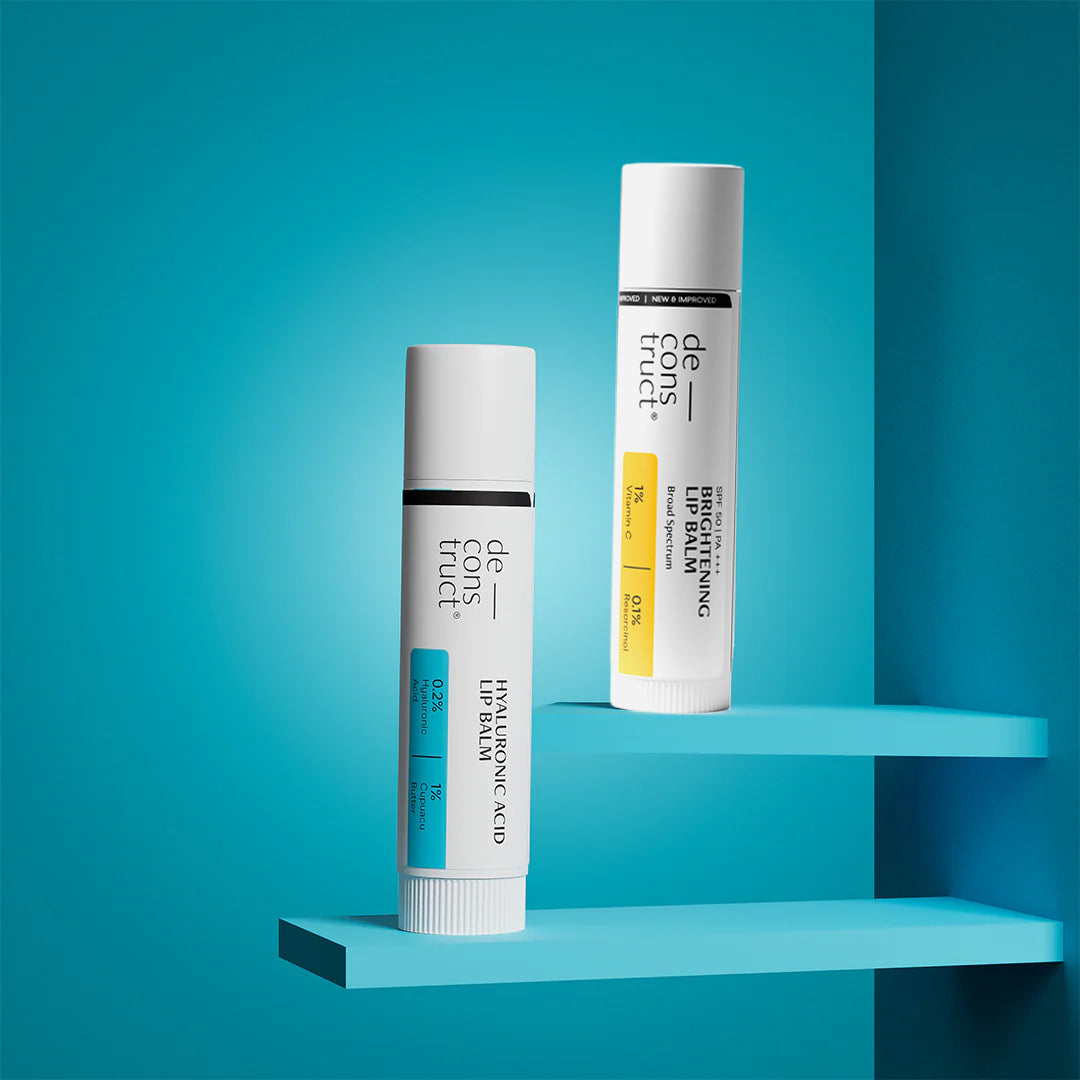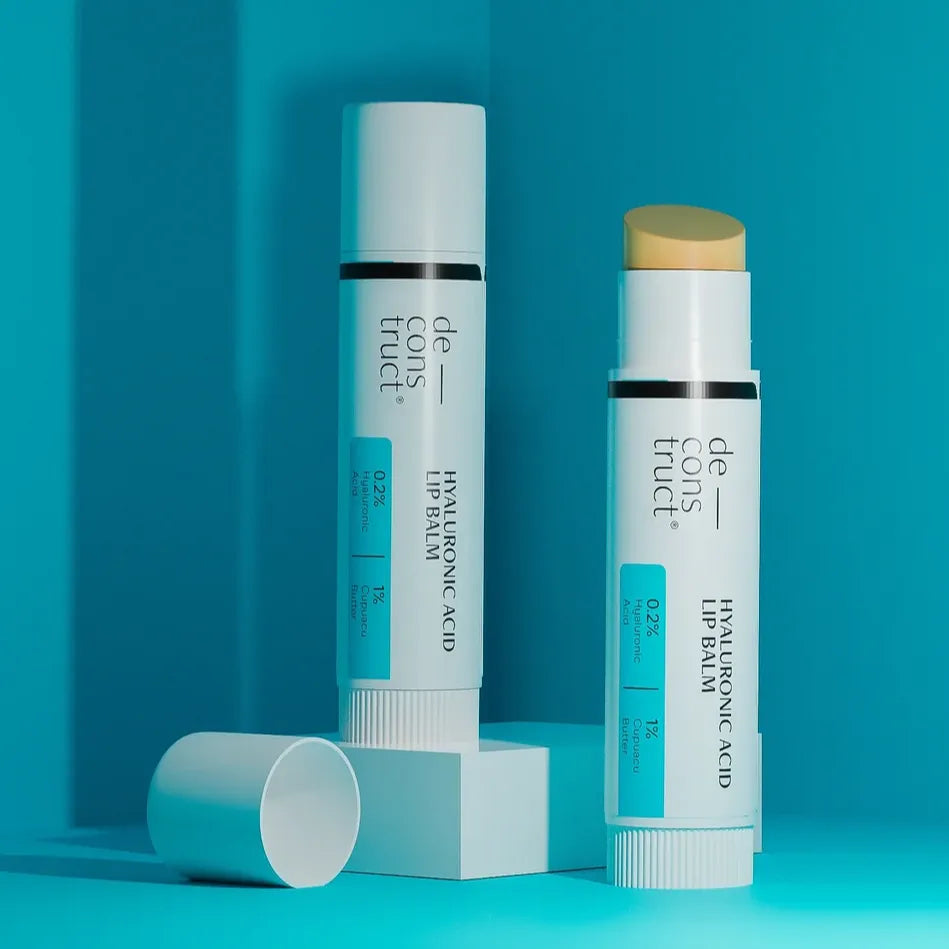Most of us have placed lip balm on dry patches, cuticles, or even pimples when we didn't have anything else. You might believe that if a lip balm makes your lips feel better, it would work on other parts of your skin too. But can a lip product actually help or hurt your acne and skin on your face?

Deconstruct — Brightening Tinted Lip Balm (1% Vitamin C + 0.1% Resorcinol, SPF 30 PA++)
Lip balms are developed to work on your lips' thin, oily, and dry skin. The structure, balance of sebum, and microbial activity of facial skin, especially skin that is prone to acne are all very different. Using the wrong kind of balm in the wrong place can sometimes make things worse.
Before we get started with the blog, you can learn more about the science behind lip balms and how they function in our Lip Balm Guide.
1. Can I Apply Lip Balm on My Face?
Why You Should Only Put Lip Balm on Your Lips
Lip balms are designed to be occlusive, which means they make a barrier that keeps moisture in and stops water from leaving the skin. That's good for lips because they don't have any oil glands.
On the other hand, the skin on your face creates its own oils and needs lotions that let air in. When you put a thick balm on your face, especially one containing waxes or rich emollients, it can trap sweat, bacteria, and dead skin cells underneath.
What Makes Lip Balm Different from Face Moisturizer
|
Feature |
Lip Balm |
Face Moisturizer |
|
Texture |
Thick and occlusive |
Light and breathable |
|
Primary Purpose |
Barrier protection |
Hydration and repair |
|
Common Ingredients |
Waxes, butters, petrolatum |
Humectants, ceramides, niacinamide |
|
Target Area |
Lips (no sebaceous glands) |
Skin with active oil glands |
|
Acne Safety |
Often comedogenic |
Formulated non-comedogenic |
So, even while a balm could relieve a flaky nose or cheek for a little while, it's not designed to be worn on the face all the time, especially if your skin is sensitive or prone to acne.
2. Can I Put Lip Balm on My Pimples?
A lot of people report that lip balm makes pimples "dry out" faster. But the only thing that matters is what is in the balm.
What it can do
A balm with calming components like vitamin E, ceramides, or shea butter may help calm down inflamed areas for a short time. The occlusive barrier can avoid injured skin from becoming worse, just like petroleum jelly protects small cuts.
If your lip balm has wax, heavy butters, fragrance, or menthol:
-
Make acne worse by blocking pores
-
Make active pimples hurt or burn
-
Cause folliculitis (tiny plugged lumps)
Dermatologists advice that lip balms are not for treating spots. Unlike pimple patches or targeted serums with salicylic acid or niacinamide, balms don't kill germs or lower inflammation. They just cover the area.
3. How Do You Apply Lip Balm to Your Face?
If your nose or chin feels flaky from the cold or dryness after taking retinoids, a small application of a fragrance-free balm can help. If you must, you should only use it on little dry areas, not all over your face.
For long-term hydration, switch to a barrier-repair moisturizer that has humectants including hyaluronic acid, ceramides, and glycerin. Instead of just holding water on top, these pull it into the skin.
4. Can Lip Balm Be Used on Skin?
In various cases, lip balm could help things other than the lips for a brief time
-
Cuticles or knuckles: Fills in cracks and softens dry patches
-
Around noses during colds: Stops tissues from rubbing against each other
-
Under lipstick or matte tints: Works as a primer for smoother texture
Avoid using lip balm on:
-
Areas with acne
-
Oily areas like the forehead or chin
-
Sensitive skin
Lip balm is thick and occlusive, made to protect the delicate, oil-free skin of the lips.
Use skin balms for sensitive areas, as they are lighter and designed for broader use. It hydrates and repairs dry or flaky areas without clogging pores.
You can also optt for healing balms that are suitable for the skin, non-comedogenic balms with minimal ingredients and no flavor.
5. Lip Balm for Acne-Prone Skin — Is It Safe?
For acne-prone skin, choose lip balms free of pore-clogging ingredients like coconut oil, cocoa butter, and lanolin. Opt for lightweight options with shea butter, squalane, or jojoba esters for better breathability.
Use fragrance-free, dermatologist-tested formulas and apply sparingly to keep lips soft without triggering breakouts.
Product Recommendation:
Deconstruct Brightening Tinted Lip Balm with 1% Vitamin C and 0.1% Resorcinol (SPF 30 PA++) and Deconstruct Brightening Lip Balm with SPF 30 are dermatologist recommended and are safe for the thin skin of lips and have brighteners and UV filters in the proper levels for that area.
6. Is Lip Balm a Good Moisturizer for Skin?
Yes, occasionally.
If your nose or chin feels flaky from the cold or dryness after taking retinoids, a small application of a fragrance-free balm can help. You should only use it on little dry areas, not all over your face.
For long-term hydration, switch to a barrier-repair moisturizer that has humectants including hyaluronic acid, ceramides, and glycerin. Instead of just holding water on top, these pull it into the skin.
7. Is Lip Balm Comedogenic?
These lip balm alternatives are authorized by dermatologists:
|
Concern |
Best Alternative |
Why It Works |
|
Redness / irritation |
Niacinamide gel or aloe-based moisturizer |
Calms inflammation |
|
Open pimple healing |
Hydrocolloid patch |
Absorbs pus, speeds repair |
|
Cracked corners (angular cheilitis) |
Antifungal or antibiotic cream |
Treats underlying cause |
|
Flaky dry spots |
Barrier-repair ointment |
Hydrates without clogging pores |
Put a thin layer of plain petrolatum (Vaseline) on your skin at night to keep it safe. It won't block your pores and is harmless for your skin.
8. Final Verdict: Should You Use Lip Balm on Face or Pimples?
If you acquire pimples around your mouth or chin after putting on lip balm, you may have perioral dermatitis, which is a mild inflammatory condition that is usually caused by things that block pores or have a strong smell.
You should contact a dermatologist if you experience bumps, dryness, or redness around your lips that won't go away. Instead of preparing your own balms, they can advise pharmaceutical creams or antibiotic gels.
FAQs
Can lip balm cause pimples?
Yes, some balms with comedogenic ingredients like waxes, lanolin, or fragrances can clog pores and cause breakouts.
Can I use lip balm on dry patches of my face?
Yes, but only occasionally and in small areas. Avoid acne-prone zones.
Is it okay to use tinted lip balm on my cheeks?
It’s not recommended. Pigments and added scents may irritate or clog pores.
Can petroleum jelly help pimples heal?
It can protect healing skin from dryness but doesn’t treat acne itself.
What’s the safest alternative to lip balm for pimples?
A hydrocolloid patch or niacinamide gel works better without clogging pores.





